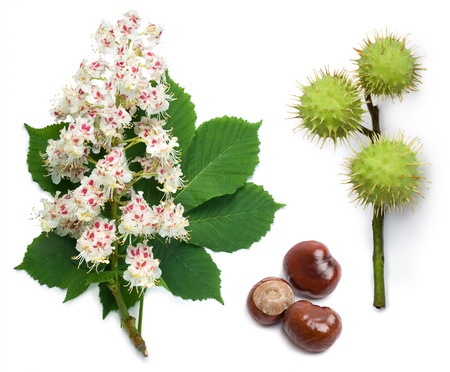 />
/>
Latin Name: Aesculus hippocastanum
Family: Sapindaceae
Genus: Aesculus
Common Names: horse-chestnut, conker tree, buckeye
Origin: native to a small area in the Pindus Mountains mixed forests and Balkan mixed forests of South East Europe
Distribution Area: it can be found in many parts of Europe as far north as Gästrikland in Sweden, as well as in many parks and cities in the United States and Canada
Botanical Information: Deciduous tree of up to 25 m high. Leaves are large, complex, five to seven fingered, with long petioles. They form a dense crown. Flowers are campanulate, asymmetric, fragrant with a strong, pleasant smell. Chestnut fruit is a ball-shaped green capsule (walnut), 6-8 cm in length, seated with prickly thorns. The fruit contains 1-4 seeds.
CHEMICAL COMPOSITION
Saponins (escin), tannins, starch, vitamin C, vitamin A, vitamin K, B vitamins, thiamine, coumarins, glycosides, pectins, flavonoids (rutin), mucilage, organic acids, lecithin, globulin, fatty oils.
In addition to the listed components, there is a whole complex of mineral substances, macro- and microelements, including calcium, iron, nickel, zinc, boron, chromium, barium, selenium, iodine and silver. Such a unique composition provides a wide application of the plant in the treatment of a variety of diseases and conditions.
HORSE CHESTNUT LIQUID EXTRACT
10 g of flowers or peeled chestnut fruits are crushed and poured with 100 ml of vodka, and then the mixture is put for infusion for one week in a dark place. During infusion, tincture should be periodically shaken. The strained tincture is drunk 30 drops three times a day.
“The Chestnut tree does not know it is naked nor imperfect; instead, it srands proud and unapologetic for all those whose opinions matter not.”
Chris Knight
*This article is for informational purposes only. We suggest consulting with a physician before using these or any other herbal supplements.
